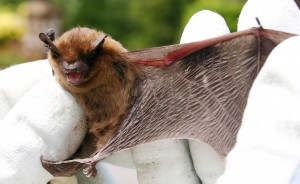
Pipistrelle Bat
The conservation charity says that is hopes the reserve, which is generously supported by Scottish Natural Heritage, will become a centre of learning and research for the flying mammals and increase public awareness of how to live in harmony with these nocturnal animals.
Both bats and their roosts are protected by law in the UK. Over the past century, their populations have suffered serious decline. Now there are signs which suggest that some species’ numbers are now starting to stabilise and recover.
From today, visitors to Threave can take part in a Bat Trail and learn more about where bats roost at the property and the seven species that have made their home there. During a Bat Mobile will tour the Threave Estate and beyond, stimulating visitors to learn more about these fascinating creatures, their habitats and their habits. Visitors will also have the opportunity to learn bat detecting skills and get their ear in at listening to different species of bats.
The charity’s interim chairman and lifelong conservationist Dick Balharry conducted the formal opening. Mr Balharry said, “More than three quarters of the National Trust for Scotland’s properties are home to bats. That means over the years, we have built up considerable expertise in bat conservation, we know where they like to live, what they like to eat and how they need to be protected. The Threave Bat Reserve Scotland’s first ever dedicated reserve, will help protect bats and their habitats for the future, enabling us to educate others in the care and protection of these fascinating creatures.”
Nature Conservation Officer, Mr Lindsay Mackinlay said, “Threave is the perfect spot for Scotland’s first bat reserve. Home to a diverse bat population, its buildings and woodland provide plenty of roosting spots and its beautiful gardens, rich meadows and wetlands mean an abundance of insects for bats to feed on.
“A lot of work by a lot of people has gone into establishing this exciting new reserve and we would invite folk to come down, open their minds and be amazed by these quite extraordinary yet badly understood animals.
“We hope that by spreading the word about the bats, their habits and habitats, we will help make bats the common sight they used to be everywhere.”
Chris Miles, Scottish Natural Heritage area manager said, “We hope that what the Trust have done here at Threave will encourage others to think positively about living with bats. There are ideas here for those who currently manage open space around buildings and also for those who design new developments. At the end of the day bats choose to live with us and we should do what we can to help these remarkable animals survive in a changing world.”
Threave is home to seven species of bat, including the rare Whiskered Bat and the NTS expects this number to increase as more research takes place on the property.
The estate also includes Threave Castle and Nature Reserve, home to ospreys, otters, thousands of geese and a myriad of wild flower species. It also includes the stunning Threave Garden, with excellent restaurant and shop, Threave School of Practical Gardening, the beautiful Threave House with its fascinating collection of domestic and agricultural items that are indigenous to Dumfries and Galloway.
